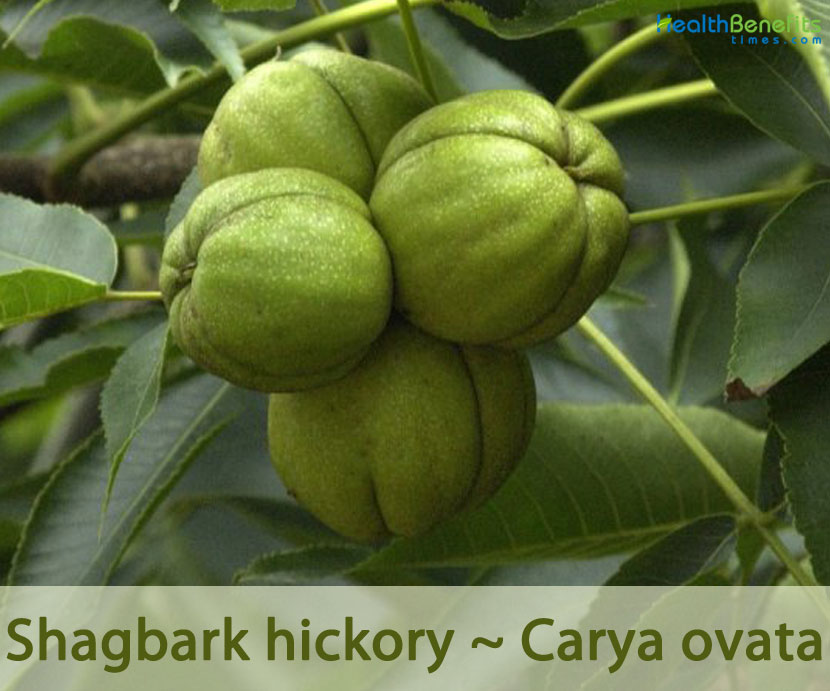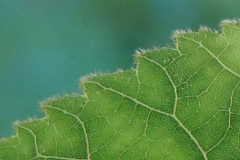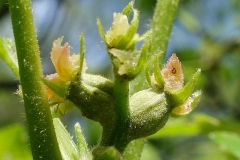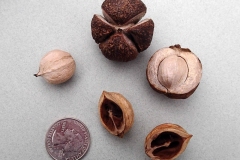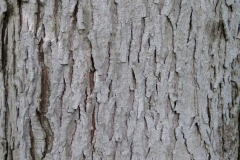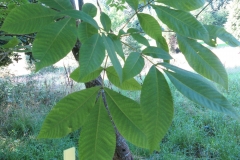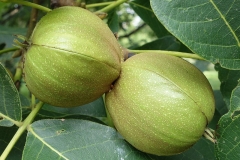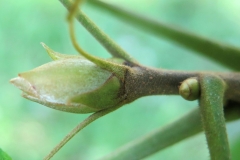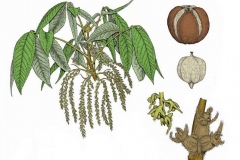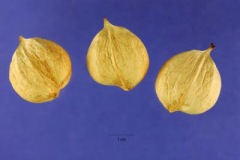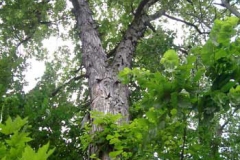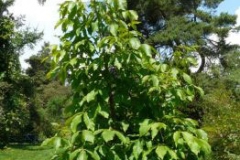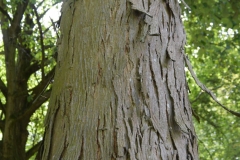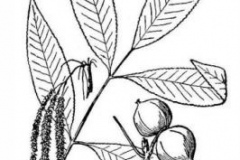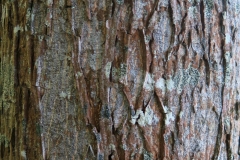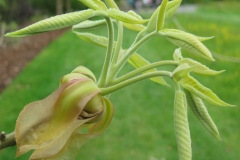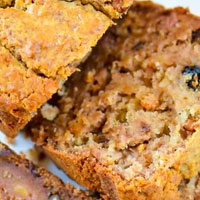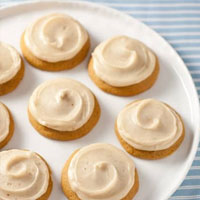The genus name Carya is the Greek name for walnut, and in Greek mythology Laconian princess Carya had a love affair with the god Dionysus; after her death, he memorialized her by changing her into a fruitful walnut tree. The specific epithet ovata means egg-shaped, referring to the nut, and the common name hickory was adapted from the Virginia Algonquian word pawcohiccora, referring to a staple food of pounded hickory nuts and water. The common name refers to the way the bark peels away from the trunk in long strips. Nuts were an important food source to Native Americans and early settlers, and are commercially sold today. Nuts are attractive to a variety of wildlife. Bark of young trees is gray and smooth, but exfoliates in long strips with age. Hickory wood is often used to cure/smoke meats. It is also an excellent firewood/fuel. The wood is extremely hard and is used to make a variety of products including tool handles, ladders, gun stocks and furniture.
Shagbark Hickory Facts
| Shagbark hickory Quick Facts | |
|---|---|
| Name: | Shagbark hickory |
| Scientific Name: | Carya ovata |
| Origin | Eastern North America but is largely absent from the southeastern and Gulf coastal plains and the lower Mississippi Delta |
| Colors | Green when young turning to brown to reddish-brown as they mature |
| Shapes | Drupe 2.5 to 4.0 cm (1 to 1+1⁄2 in) long, an edible nut with a hard, bony shell, contained in a thick, green four-sectioned husk |
| Health benefits | Beneficial for headaches, rheumatism, coronary heart disease, Central Nervous System and kidney health |
| Name | Shagbark hickory |
|---|---|
| Scientific Name | Carya ovata |
| Native | Eastern North America but is largely absent from the southeastern and Gulf coastal plains and the lower Mississippi Delta. It is found from southeastern Nebraska and southeastern Minnesota eastward through southern Ontario and Quebec to Maine and extends southward to Georgia, Alabama, Mississippi, Louisiana, and eastern Texas. Disjunct populations have been reported in the mountains of northeastern Mexico |
| Common Names | Shagbark hickory, shellbark hickory, scalybark hickory, shagbark, upland hickory, Carolina Hickory, Caryer ovale, Noyer tender, mockernut, Whiteheart Hickory |
| Name in Other Languages | Bulgarian: Yaytsevydno khykory (яйцевидно хикори) Catalan: Noguera blanca americana Czech: Ořechovec vejčitý Dutch: Witte bitternoot English: Caryer ovale, Noyer tender, Shagbark hickory, Shellbark hickory, Upland hickory, mockernut, Whiteheart Hickory, Shag-Bark Hickory Finnish: Valkohikkori French: Carya blanc, Caryer ovale, Noyer blanc, Noyer tender, Arbre à noix piques, Caryer blanc, Noix douces, hickory veritable, noyer tendre German: Schindelborkige Hickorie, Schuppenrindenhickory Hungarian: Fehér hikoridió Italian: Hickory minore Mexico: Nogal Cimarron, nogal motudo, nogal rayado, nogalillo Netherlands: Bitternoot, witte Norwegian: Skihickory Polish: Orzesznik pięciolistkowy Russian: Kariya yaytsevidnaya (Кария яйцевидная) Slovak: Orechovec Spanish: Caria blanca, nogal americano Swedish: Skidhickory Ukrainian: Kariya ovalʹna (Карія овальна), kariya bila (карія біла) USA: Carolina hickory, scalybark hickory, shellbark hickory, upland hickory |
| Plant Growth Habit | Medium to large, slow-growing, long-lived, broadly conical, deciduous hardwood tree |
| Growing Climates | Dry upland slopes, lowland, valleys, lower slopes of wooded bluffs, in ravines, at the edges of swamps, wet bottomlands, rocky hillsides, limestone outcrops, drier areas of floodplain woodlands, bluffs, and edges of limestone glades |
| Soil | On deep, rich, moist soils. It occurs on soils derived from a variety of sedimentary and metamorphic parent materials and grows across a wide range of soil fertility conditions. It appears to be tolerant of soils with high concentrations of lead and zinc |
| Plant Size | 60 or 80 feet (20-25 m) in height and up 20 inches (51 cm) in diameter. On favorable sites, trees may grow to 131 feet (40 m) or more in height and reach up to 9 feet 8 inches (295 cm) in diameter |
| Root | Deep Taproot with spreading lateral roots |
| Bark | Initially smooth and gray then becoming dark gray, fissured and deeply furrowed, exfoliating in long strips or broad plates, persisting and curling away from stem |
| Branchlets | Greenish to brown, stout or slender, glabrous or pubescent |
| Twigs | Stout, brown and hairy when young, becoming gray and smooth; pores pale and elongated |
| Buds | Terminal bud ovoid, 0.6–1.8 cm long, tan to black, glabrous or tomentose |
| In Leaf | June to October |
| Leaf | Alternate, pinnately compound leaves are odd-pinnate with 5 leaflets. Individual leaflets are 3-8 inches long and about one-half as much across. The terminal leaflet is the largest, while the lowest lateral leaflets (first pair of a compound leaf) are the smallest. Leaflets are obovate or broadly elliptic in shape and their margins are serrated. Tiny tufts of hair occur along the teeth of the margins, although these tend to fade away with age |
| Flowering season | April – June |
| Flower | Shagbark hickory is monoecious. Staminate flowers are borne on long-stalked catkins at the tip of old wood or in the axils of the previous season’s leaves. Pistillate flowers occur in short terminal spikes |
| Fruit Shape & Size | Drupe 2.5 to 4.0 cm (1 to 1+1⁄2 in) long, an edible nut with a hard, bony shell, contained in a thick, green four-sectioned husk which turns dark and splits off at maturity in the fall |
| Fruit Color | Green when young turning to brown to reddish-brown as they mature |
| Propagation | By seed and by vegetative means |
| Lifespan | About 200 years, but some longer-lived shagbarks can continue to produce seeds until age 300 |
| Season | October to November |
| Varieties |
|
| Precautions |
|
Plant Description
Shagbark hickory is a medium to large, slow-growing, long-lived, broadly conical, deciduous hardwood tree that normally grows about 60 or 80 feet (20-25 m) in height and up 20 inches (51 cm) in diameter. On favorable sites, trees may grow to 131 feet (40 m) or more in height and reach up to 9 feet 8 inches (295 cm) in diameter and can live more than 350 years. The tallest measured shagbark, located in Savage Gulf, Tennessee, is over 150 ft. (46 m) tall. Mature shagbarks are easy to recognize because, as their name implies, they have shaggy bark. This characteristic is, however, only found on mature trees; young specimens have smooth bark. The plant is found growing in dry upland slopes, lowland, valleys, lower slopes of wooded bluffs, in ravines, at the edges of swamps, wet bottomlands, rocky hillsides, limestone outcrops, drier areas of floodplain woodlands, bluffs, and edges of limestone glades. The plant prefers deep, rich, moist soils. It occurs on soils derived from a variety of sedimentary and metamorphic parent materials and grows across a wide range of soil fertility conditions. It appears to be tolerant of soils with high concentrations of lead and zinc.
Bark
Bark is distinctive, at first smooth and gray then becoming dark gray and deeply furrowed into long wide plates, that remain attached in the middle but curve away from the trunk at each end – resulting in the shaggy appearance the tree is named for.
Twigs
Twigs are brownish and stout with numerous lighter colored lenticels, minutely hairy and with the 3-lobed leaf scar the Walnut family usually has, which is said to resemble a monkey face. Buds are tan to red-brown to dark brown and variously covered in matted hairs. The terminal bud is oval to egg-shaped with slightly flaring scales and may be nearly ¾ inch long. The inner bud scales greatly expand after bud-break and become quite showy, resembling flower petals.
Leaves
Alternate, pinnately compound leaves are odd-pinnate with 5 leaflets (less often with 3 or 7 leaflets) and about 8-14 inches long. Rachis (central stalk) of each compound leaf is light green and either glabrous or sparsely short-pubescent. At maturity, individual leaflets are 3-8 inches long and about one-half as much across. The terminal leaflet is the largest, while the lowest lateral leaflets (first pair of a compound leaf) are the smallest. Leaflets are obovate or broadly elliptic in shape and their margins are serrated. Tiny tufts of hair occur along the teeth of the margins, although these tend to fade away with age. For mature leaves, the upper leaflet surface is medium to dark green, shiny, and hairless, while the lower leaflet surface is pale green, dull, and hairless (or nearly so). Leaves turn yellow to golden brown in fall. Sometimes the lower leaflet surface of mature leaves has short fine hairs along the veins. At the base of each leaflet, there is a short petiolule (basal stalklet) that is light green and either glabrous or short-pubescent. Petiolules of the lateral leaflets are about 1/8 inches (3 mm.) long, while the petiolule of each terminal leaflet is about ½ inches long. The petioles of the compound leaves are 3-6 inches long, light green, and either glabrous or sparsely short-pubescent.
| Leaf arrangement | Alternate |
| Leaf type | Odd-pinnately compound |
| Leaf margin | Serrate |
| Leaf shape | Oblanceolate, oblong, lanceolate |
| Leaf venation | Pinnate |
| Leaf type and persistence | Deciduous |
| Leaf blade length | 4 to 8 inches |
| Leaf color | Green |
| Fall color | Yellow |
| Fall characteristic | Showy |
Flower
Shagbark Hickory is monoecious, producing separate male (staminate) and female (pistillate) flowers on the same tree. The male flowers are produced in drooping yellowish green catkins near the tips of twigs. These catkins are arranged in groups of 3 (catkins in each group sharing the same basal stalk) and they are 10 to 15 cm (4 to 6 in) long and develop from axils of previous season leaves or from inner scales of the terminal buds at the base of the current growth. Individual male flowers are yellowish green, less than 1/8 inches (3 mm.) across, consisting of several (with up to 10) hairy stamens and an insignificant calyx. Each male flower is partially hidden by a 3-lobed bract. The female flowers are produced in short greenish spikes (about 1/3 inches or 8 mm. long) at the tips of young shoots. There are typically 2-3 female flowers per spike. Individual female flowers are about 1/8 inches (3 mm.) long and ovoid in shape, consisting of a calyx and a pistil with spreading green stigma at the top. The blooming period occurs from April – June as the leaves develop. The flowers are cross-pollinated by the wind.
| Flower color | Green |
| Flower characteristics | Showy |
Fruit
Fertile female flowers are replaced by nearly sessile clusters of 1-3 fruits that develop during the summer and mature during autumn of the same year. Individual fruits are 1½-2 inches long and 1½-2 inches across (or a little less). They are oval to subglobose or obovoid, depressed at the apex, and enclosed in a thin husk developed from the floral involucre. The fruit ripens in September and October and seeds are dispersed from September through December. The thick hairless husks of the fruits are light green while immature, becoming brown to brownish black at maturity. The husks become dry at maturity and each husk is divided into 4 segments that are indented at their margins, providing the fruit with a ribbed appearance. The enclosed nut is light brownish white, oblong-ovate, somewhat compressed, usually prominently four-angled at the apex and rounded at the base. The shell is relatively thin and the kernel is sweet and edible. The bulk of the edible embryonic plant is cotyledonary tissue. Nuts are dispersed by animals. Trees must be around 40 years of age to produce a good crop. Cold stratification is needed for seed germination.
| Fruit shape | Oval, round |
| Fruit length | 1 to 3 inches |
| Fruit covering | Dry or hard |
| Fruit color | Brown, green |
| Fruit characteristics | Attracts squirrels/mammals; showy; fruit/leaves a litter problem |
Traditional uses and benefits of Shagbark hickory
- The fresh small shoots have been steamed to make an inhalant for treating headaches.
- Decoction of the bark has been taken internally to treat rheumatism and also used as a poultice on rheumatic joints.
- They are rich in vitamin B1 which helps in the proper functioning of the heart, muscles and the Central Nervous System.
- It is also rich in Magnesium which helps the kidneys, muscles and heart to function properly.
- The risk of coronary heart disease is low as the nuts consist of low amounts of saturated fat.
Culinary Uses
- Seed can be consumed raw or cooked and used in pies, cakes, bread etc.
- Seed can be ground into a meal and used to thicken soups etc.
- Nut milk can be prepared from the seed and this is used as a butter on bread, vegetables etc.
- Shell is normally thick and hard but in selected cultivars it can be thin.
- Seed ripens in late autumn and can be stored for up to 2 years in a cool cellar.
- It is tapped in spring and can be made into syrup.
- Hickory nuts were a food source for Native Americans, who used the kernel milk to make corn cakes and hominy.
- Bark of the shagbark hickory is also used to flavor maple-style syrup.
Wild Persimmon and Hickory Nut Bread
Ingredients
- 14 Tablespoon , softened Butter
- 36 Tablespoon (4 Tablespoons Plus 2 Cups) of Unshifted flour
- 1 Teaspoon Baking soda
- 1/2 Teaspoon Salt
- 1 Pound (Fully Ripe Wild Variety, 2 Dozens) Persimmons
- 1 Cup (16 tbsp.) Sugar
- 2 Eggs
- 1 Cup (16 tbsp.) Coarsely chopped hickory nuts
Directions
- Preheat the oven to 325°.
- Take two 9-by-5-by-3-inch loaf pans and spread 2 tablespoons of the softened butter over the bottom and sides of the pans using a pastry brush.
- To each pan add 2 tablespoons of the flour and tip the pan back and forth to distribute the flour evenly.
- Invert the pans and rap them sharply on the bottoms to remove the excess flour.
- Sift together combining the 2 cups of flour, the baking soda and salt onto a plate or sheet of wax paper and set aside.
- To prepare the persimmons wash them gently under cold running water and let them drain in a colander.
- With a small sharp knife, cut them into quarters and pick out the seeds.
- Set a food mill over a bowl and puree the persimmons through or rub them through a coarse sieve with the back of a spoon and collect about 1 cup of pureed fruit.
- In a deep bowl, cream the remaining 12 tablespoons of softened butter and the sugar by beating and mashing them against the sides of the bowl with the back of a spoon until light and fluffy.
- Beat in the eggs, one at a time and add 1 cup of the flour mixture.
- When it is thoroughly incorporated, beat in about 1/2 cup of the pureed fruit.
- Add the remaining 1 cup of the flour mixture and then the rest of the puree, beating well after each addition and stir in the hickory nuts.
- Into the two buttered-and-floured pans, pour the batter dividing it equally between them and spreading it evenly with a rubber spatula.
- Bake in the middle of the oven for about 1 hour until the loaves begin to shrink away from the sides of the pans and a toothpick or cake tester inserted in the centers comes out clean.
- Turn the loaves out on wire racks to cool.
- Serve the bread warm or at room temperature.
Pumpkin Cookies with Browned Butter Frosting
Ingredients
Cookies
- 2/3 cup granulated sugar
- 2/3 cup brown sugar packed
- 3/4 cup butter softened
- 1 tsp. vanilla
- 1/2 cup pumpkin puree not pumpkin pie mix
- 2 eggs
- 2 1/4 cup flour all-purpose or fresh ground wheat* see recipe notes
- 1 tsp. baking soda
- 1 tsp. pumpkin pie spice
- 1/2 tsp. salt
Frosting
- 3 cups powdered sugar
- 1 tsp. vanilla
- 3-4 tbsp. milk
- 1/3 cup butter
- 1/4 cup nuts (hickory, walnut, pecan…) finely chopped, optional
Directions
Cookies
- Heat oven to 375F.
- Mix butter, granulated sugar, brown sugar and 1 tsp. vanilla with electric mixer until well blended, scraping the bowl occasionally. Add pumpkin and eggs, mix until well incorporated. On low speed, add flour, baking soda, pumpkin pie spice, and salt.
- On ungreased cookie sheets, drop heaping tablespoons of dough about 2 inches apart.
- Bake 10-12 minutes. Cookies are done when there is almost no indentation when touched in center. Cool completely on wire racks.
Frosting
- Mix powdered sugar, vanilla and 3 tablespoons milk in medium bowl until smooth.
- In 1-quart saucepan, heat 1/3 cup butter over medium heat, stirring constantly, until light brown.
- Pour browned butter over sugar mixture. Beat on low speed 1 minute or until smooth. If needed, add a little more of the remaining tablespoon to make frosting spreadable.
- Generously frost cooled cookies, adding chopped nuts if desired. Store in covered container.
Other Facts
- Shagbark hickory was first cultivated in 1911.
- Andrew Jackson, the seventh U.S. president and Major General during the War of 1812, was nicknamed “Old Hickory” because he was considered to be as tough as a hickory tree.
- Yellow dye is obtained from the inner bark.
- Wood is close-grained, tough, elastic, heavy and very hard. It weighs 52lb per cubic foot.
- Wood was formerly used to make wheels and spokes for wagons, carriages, carts, and early automobiles.
- Wood is currently used to make furniture, flooring, tool handles, dowels, ladders, and sporting goods.
- An excellent quality wood is used for tool handles, wheel spokes, sporting goods, baskets etc.
- Wood is an excellent fuel, burning well and giving off a lot of heat.
- It produces an excellent charcoal.
- Trees take 15 years to come into flower from seed.
- Shagbark hickory nuts are readily eaten by a wide variety of birds and mammals.
- Shagbark hickory begins producing seed at approximately 40 years of age.
- Shagbark hickory wood is used for smoking meat and for making the bows of Native Americans of the northern area.
References:
https://www.itis.gov/servlet/SingleRpt/SingleRpt?search_topic=TSN&search_value=19242#null
https://pfaf.org/user/Plant.aspx?LatinName=Carya+ovata
https://www.missouribotanicalgarden.org/PlantFinder/PlantFinderDetails.aspx?kempercode=a854
http://www.theplantlist.org/tpl1.1/record/kew-2701831
https://www.fs.fed.us/database/feis/plants/tree/carova/all.html
https://www.rhs.org.uk/plants/21418/carya-ovata-(f)/details
https://gd.eppo.int/taxon/CYAOV
https://www.cabi.org/isc/datasheet/17240#toidentity
https://www.nwf.org/Educational-Resources/Wildlife-Guide/Plants-and-Fungi/Shagbark-Hickory
https://powo.science.kew.org/taxon/urn:lsid:ipni.org:names:30122806-2
https://en.wikipedia.org/wiki/Carya_ovata
https://edis.ifas.ufl.edu/publication/ST123
http://luirig.altervista.org/schedenam/fnam.php?taxon=carya+ovata
https://www.minnesotawildflowers.info/tree/shagbark-hickory
https://www.illinoiswildflowers.info/trees/plants/shbk_hickory.html
https://arboretum.uoguelph.ca/thingstosee/trees/shagbarkhickory
https://plants.usda.gov/home/plantProfile?symbol=CAOV2


